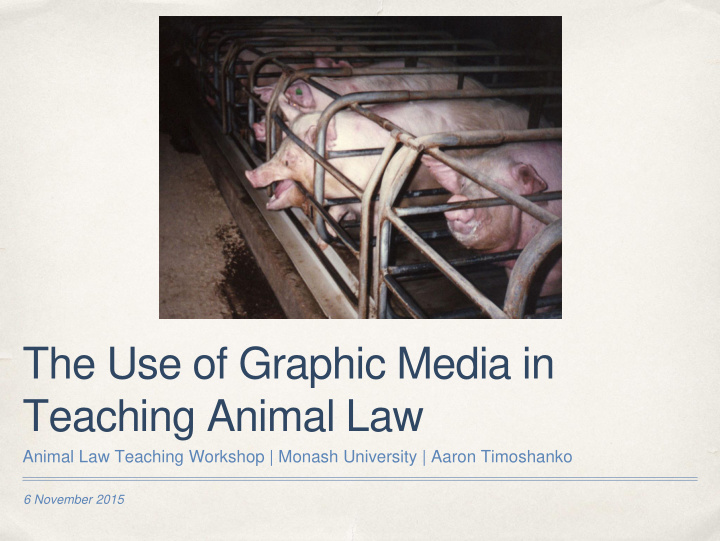



The Use of Graphic Media in Teaching Animal Law Animal Law Teaching Workshop | Monash University | Aaron Timoshanko 6 November 2015
Growth of Animal Law ✤ Since 2005 there has been a steady increase in the number of universities offering Animal Law. ✤ Many academics teaching Animal Law for the first time ✤ This was me earlier this year - I’m a newbie!
Graphic Media ✤ One of the key questions for me was whether to use graphic media ✤ ‘Graphic media’ is film or still images that most students will find confronting and/or distressing ✤ Very broad: from the extreme (gory) to the routine ✤ Subjective phenomena ✤ e.g. lawful confinement of sows or layer hens ✤ The key question: does graphic media promote student learning and engagement? ✤ Not a lot out there offering guidance ✤ Probably due to the ethical dimension ✤ Although I advocate for the use of graphic media I am not suggesting that all academics should use graphic media or that courses without graphic media are somehow deficient
Methodology ✤ Relying upon research and literature on: ✤ The teaching of sensitive topics (e.g. rape law, international criminal law); and ✤ Non-graphic media (audio-visual tools for learning) ✤ There are some obvious points of distinction but there is also sufficient overlap for valuable comparisons to be made.
Student Engagement ✤ Student engagement is ‘a crucial cornerstone of quality teaching and learning’. ✤ Perform better academically ✤ More likely to complete their studies ✤ 4 types of engagement: cognitive, affective, conative and relational ✤ Focus here is on affective engagement: based on students’ reporting ✤ Positive vs negative affective engagement ✤ Some negative affective engagement may promote agency but others may hinder or detract from students learning experience.
Does graphic media promote student engagement? ✤ As an ‘affective strategy’ graphic media can promote student engagement ✤ Links abstract concepts to reality (e.g. animal welfare) by providing context ✤ Provides an authentic learning experience ✤ Film and images can stimulate interest ✤ Promotes empathy and compassion
Other Benefits ✤ Produces mature and emotionally-balanced graduates who are able to productively handle their emotions - especially valuable for future lawyers
Arguments Against Graphic Media ✤ Emotionally taxing - especially in prep phase (cutting out the gore) ✤ Even employing self-care strategies, harm is a risk (PTSD) due to repeated exposure (9/11 footage) ✤ Students (and academic) may experience ‘content fatigue’ or apathy ✤ Time consuming - high degree of ‘commitment and critical intelligence’ ✤ Final section provides some guidance ‘critical intelligence’
Arguments Against Graphic Media ✤ Students will disengage/ withdraw from the topic due to negative emotional states. Risk is more apparent when one of the following considerations are out of balance: 1. Ethics of care learning environment 2. Content of the media ✤ Direct relationship between these factors ✤ There is a limit to this equation . Excessively graphic (lurid) media should never be shown, even if pedagogically justifiable: ✤ Social pressure to remain during screening - risk of negative emotional state too high. ✤ Exposure to criticism that the educator is attempting to convert students to veganism or animals rights activists!! ✤ But see: Francione
Selecting Graphic Media for Positive Affective Engagement ✤ 1st consideration: student and academic wellbeing. 2nd: pedagogical value of the media. ✤ Keep it as short as possible - lengthy videos not required to improve student engagement. 1. Does this scene/image provide real-world context for the law/regulation? 2. Is this directly relevant/applicable to [jurisdication]? 3. Does this accurately depict the use or treatment of animals in [jurisdiction]? 4. Does it convey something ‘extra’ that is lost in verbal or text -based descriptions?
Hypothetical 3: Emergency Euthanasia ✤ 4 evaluative criteria: ✤ Blunt force trauma to the 1. Real-world context? head (hammer) permissible under the MCoP for Pigs (r 2. Directly relevant to jurisdiction? 7 & app 5) 3. Accurate depiction? ✤ Satisfies questions 1, 2, 3 4. Convey something ‘extra’ ✤ However, extremely graphic (risk of disengaging) & if necessary, can be conveyed via text/speech
Hypothetical 4: Sow-Stalls ✤ 4 evaluative criteria: ✤ Aussiepigs.org 1. Real-world context? 2. Directly relevant to jurisdiction? ✤ Complies with law and 3. Accurate depiction? regs 4. Convey something ‘extra’ ✤ Satisfies the 4 merit- based questions ✤ Especially question 4
Conclusion ✤ Not prescriptive → start the conversation ✤ Graphic media can have a positive effect on student engagement providing it does not evoke a negative affective response → disengagement ✤ To avoid the risks of disengagement: ✤ Keep it short ✤ Apply ‘critical intelligence’ to every scene or image → what is its pedagogical value? ✤ Consider the four evaluative criteria: 1. Real-world context? 2. Directly relevant to jurisdiction? 3. Accurate depiction? 4. Convey something ‘extra’
Recommend
More recommend